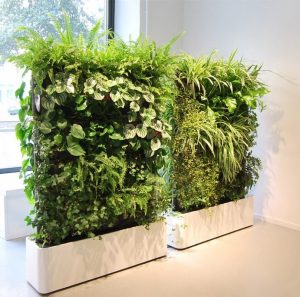The Origin
Known by several names including green walls, living walls, or vertical gardens, these architectural elements can be found on exteriors or interiors of buildings, and can range in size from just a few square feet to entire walls. They were first developed by Stanley Hart White, a professor of landscape architecture at the University of Illinois, in 1938; he created a patent for his “vegetation-bearing architectonic structure and system,” though his invention did not progress beyond prototypes in his backyard. The rise in popularity of green walls is credited to Frenchman Patrick Blanc, a botanist who took his inspiration from the waterfalls he saw in the tropical jungles of Southeast Asia.
The Definition of a Green Wall
Green walls are vertical structures that have different types of plants or other greenery attached to them. The greenery is often planted in a growth medium consisting of soil, stone, or water. Because the walls have living plants in them, they usually feature built-in irrigation systems. 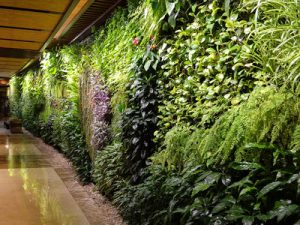
Benefits
They Increase the Feeling of Well-Being
Green walls can make us happier and more productive, as they appeal to our innate need to be around nature. Bringing in natural elements to places where they can’t generally be seen lifts our mood, making us more alert and upbeat. This concept is also known as Biophilia. Living and working in a green environment also has a positive effect on the well-being of people and reductions in stress. Blood pressure, heart activity, muscle tension, and brain activity could all be improved by viewing plants for as little as 3 to 5 minutes. As a direct consequence, cleaner air leads to fewer health complaints such as headaches and respiratory irritations, as well as increases in focus and attention. Complaints such as irritated eyes, headaches, sore throats and tiredness diminish. In offices where there is plenty of greenery, there is a noticeable decrease in absence due to illness.
Visual Benefits
Green walls make a breathtaking statement by creating alluring and inviting environments. They are as equally impressive in appearance as they are purveyors of good health; the plants in the walls work as a natural air-filtration system that building occupants can enjoy. Employees are greeted by a green lush environment while savoring the soothing effects of being around an abundance of foliage.
Reductions in Ambient Temperature
Plants absorb sunlight. More accurately, 50% is absorbed and 30% reflected. This helps to create a cooler and more pleasant climate during summer time. For the indoor climate, this means also that 33% less air conditioning is required, which in turn means energy savings.

Improved Air Quality
Living green walls are natural air-filters, creating a cleaner, more invigorating work environment that will lead to better overall employee health and production. Officer workers are often exposed to air toxins in their work environment. Living green walls metabolize harmful toxins while releasing oxygen into the workplace air, much like office plants but on a much larger scale.
Noise Level Reduction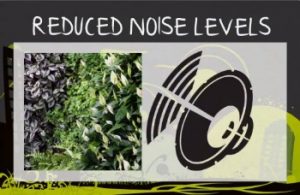
One of the lesser known benefits of living green walls, the structures can reduce noise levels in buildings. Plants have been used, throughout the world, to reduce noise along roads and highways. Living green walls expand on this concept as vegetation‘naturally’ blocks high frequency sounds while the supporting structure can help diminish low frequency noise.
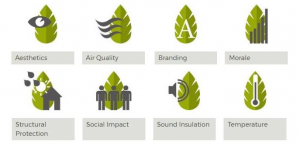
What types of Green Walls are there?
Indoor And Outdoor
Outdoor and Indoor green walls are used for different purposes and in various environments. They can be made of a range of materials and plants, depending on the most suitable solution for each space.
Outdoor green walls are primarily visual elements. Although they can also be cost effective in that they reduce overall temperatures, capture rainwater or insulate buildings, they are mostly used to bring greenery into urban landscapes. The construction of living walls has restrictions in terms of climate, as they have to endure their surrounding circumstances, which may sometimes take a toll on the structure and plants of the wall.
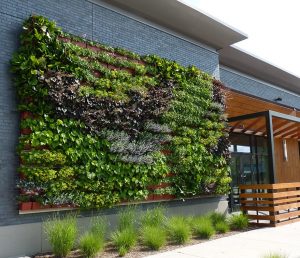
Indoor green walls, however, have more limitations in terms of their size, as they have to fit the space they are in. Because of said limitations, they are often easier to maintain, though. Moreover, the plants used in these green walls are tropical and would not survive in most conditions of the outside world when removed from their natural habitat.
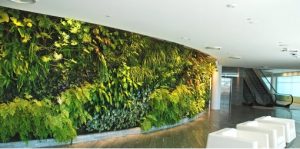
Artificial and Living
An artificial green wall is a vertical garden system made up of interlocking panels of artificial plants. High-quality artificial green walls are lifelike, low-maintenance and long-lasting. They are usually put together in sections, by fixing the back of each panel to your wall surface.
Artificial Green Walls have several advantages over living plants in the fact that there is almost 0 maintenance as the plants do not have to be watered, require pesticides or fertilizers, they never die and don’t need sunlight to survive.
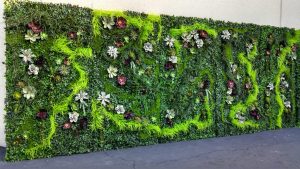
Living green walls are panels of plants, grown vertically using hydroponics, on structures that can be either free-standing or attached to walls. Living green walls are also referred to as Vertical Gardens, Living Walls or Eco-walls. Living green walls are comprised of plants that are inserted into a growing medium and then places on the wall of buildings and properties to provide greenery and the benefits of plants, but using a minimum of horizontal space.
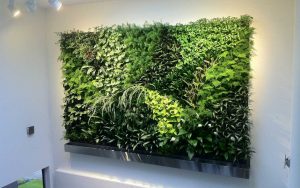
Freestanding
Freestanding green walls are the most versatile of all green walls. Freestanding Systems allow you to place your Green Wall virtually anywhere. They are an excellent application for temporary, promotional or seasonal displays. They can be both artificial and living walls. They’re easy to maintain, their installation and removal is quick and easy, they usually have self-contained automatic or manual irrigation and they give you the flexibility to easily change out plant palettes as per your needs or the seasons. They can also be used as dividers in open floor plans. Freestanding systems are the most versatile of all green walls.
